There are some things in life you can never have enough of – storage is one of them. From getting my hands on as many IBM 75GXP HDDs back in the day – affectionately known as the ‘Death Star’ series for a propensity to fail at inopportune times – to hoarding SSDs, I’m your man. This is why my interest was piqued when QNAP reached out and offered a storage-laden TBS-h574TX-i5UC-05S01 to review. To the uninitiated, that’s a jumble of letters and numbers, but to me, it signifies a Thunderbolt 4 all-flash NASbook perfect for Club386’s production needs.
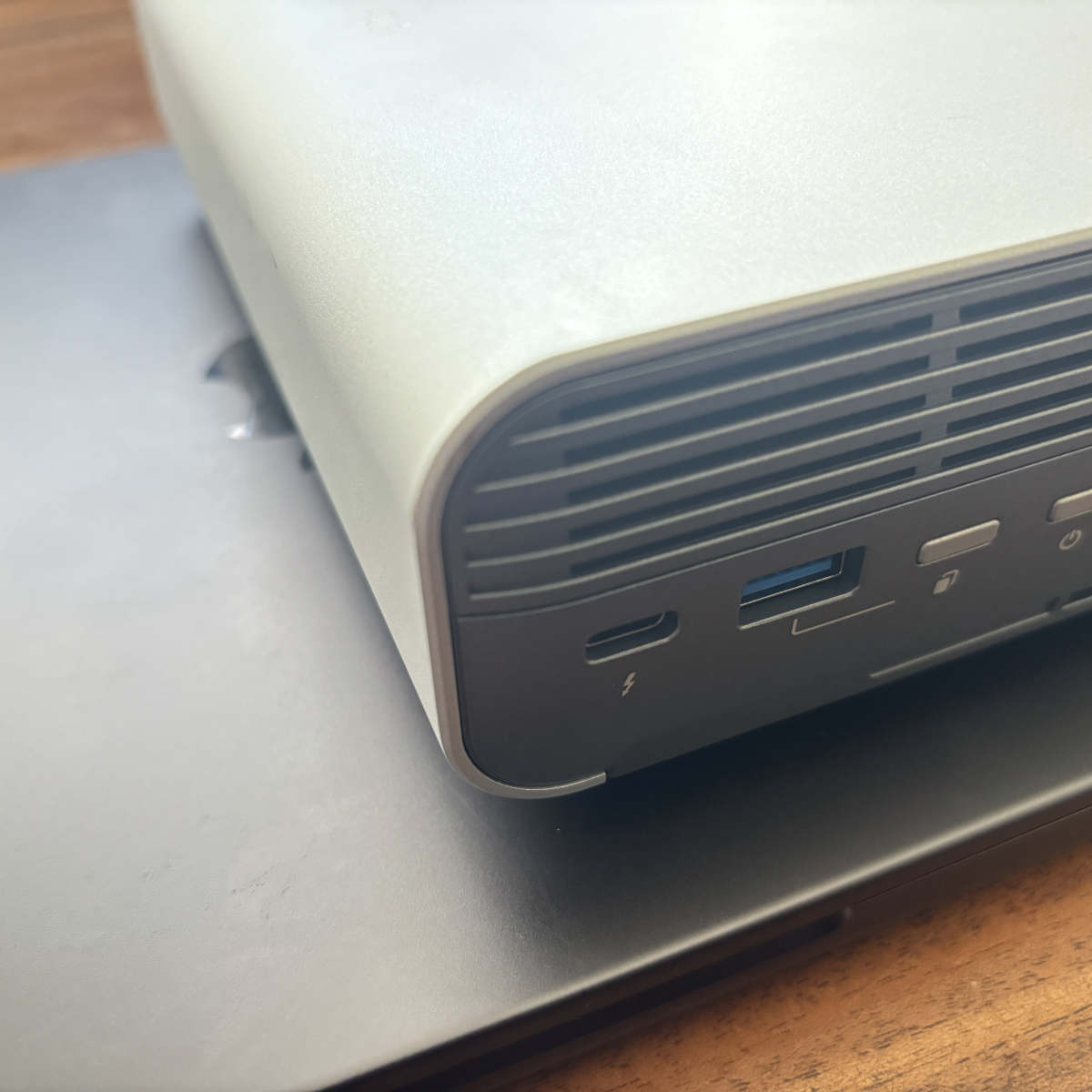

QNAP TBS-h574TX-i5UC-05S01
£3,299
Pros
- Up to 19.2TB ready to go
- Superb build quality
- Solid performance
- Super-easy to use
Cons
- Constant hum
- Thunderbolt limited to 20Gbps
- Weaker CPU than barebones
Club386 may earn an affiliate commission when you purchase products through links on our site.
How we test and review products.
Eagled-eyed readers will note that we’ve taken a look at the barebones unit before. This unit is ostensibly the same from a functional perspective, so please head over to that review for further detail, but the devil is in the details. Whereas the barebones is outfitted with a Core i5-1340P chip carrying four performance and eight efficient cores for a total of 16 threads, this pre-configured version drops down to an older-generation Core i5-1235U running two fewer performance cores, for a total of 12 threads. I’m not sure why QNAP would do this, actually, because having a lower-powered chip doesn’t do the value argument any favours.

Nevertheless, as a brief recap for those who don’t like to wander from my witty prose, all versions of this NASbook specify two Thunderbolt 4 ports for connecting to local computers or high-speed peripherals, as well as both 10GbE and 2.5GbE Ethernet to facilitate network sharing.
Do be aware that QNAP limits each TB4 port to 20Gbps maximum throughput, instead of 40Gbps, which is a shame, and I believe this is because the bridging architecture is limited to PCIe 3.0 x2, equating to around the same 20Gbps limit. A machine is only as fast as it’s slowest part.
There’s also 10Gbps USB for video ingestion and an HDMI port for displaying content on an external monitor. Inside, five E1.S slots are primed for storage, though more common, cheaper M.2 drives can be used by leveraging adapters. Just be sure to confirm chosen models adhere to the compatibility list if you’re going down the barebones route.
Without verging into hyperbole, it’s both a one-stop editing and storage shop for budding video creators, doubling up as a giant file repository for the likes of yours truly.
Specifications, design and build
| QNAP TBS-h574TX-i5UC-05S01 | |
|---|---|
| CPU | Intel Core i5-1235U, 10 cores, 12 threads |
| Memory | 16GB non-expandable |
| Storage | 5x QNAP E1.S 1.92TB |
| Networking | 1x 10GbE, 1x 2.5GbE |
| USB | 2x 10Gbps, 1x 480Mpbs |
| Thunderbolt | 2x TB4 20Gbps |
| HDMI | 1x 1.4 |
| Dimensions | 215mm x 199mm x 69mm (WxDxH) |
| Weight | 2,452g, including drives |
| Fans | 2x 40mm (exhaust), 1x 75mm (CPU) |
| OS | QNAP QTS 5.26 |
| Power consumption | 46W (typical) |
| Warranty | Three years |
| Price | £3,299, including drives |

What’s different in this particular instance, however, is QNAP appreciates the target market of video creators and small businesses don’t necessarily want to be faffing with installing drives. Rather, they need a turnkey solution ready to rock and roll. There are two models servicing this ease-of-use, and both have wonderfully complex names.
The review model rolls off the tongue with TBS-h574TX-i5UC-05S01 nomenclature. In reality, it translates to the Intel Core i5-powered base unit plus five pre-installed E1.S SSDs each with 1.92TB capacity, leading to 9.6TB in total. A sign of how memory prices have shot up, this very unit fetched a shade under £3,000 when it arrived on my doorstep. Fast forward to today and the very same unit is £3,299. Meanwhile, if you need maximum capacity, the TBS-h574TX-i5UC-05S02 is exactly the same save for doubling the per-drive E1.S capacity to 3.84TB, totalling a whopping 19.2TB and yours for a cool £4,972. Both are backed by a five-year warranty.
Whether or not the premium for the preconfigured 9.6TB/19.2TB capacities over the barebones model is worth it depends upon viewpoint. You can absolutely build a cheaper all-NAS array of the same or larger capacity by using traditional M.2 SSDs, even with recent price escalations, but that’s missing the point. E1.S SSDs, by their very nature, are designed to work in servers, typically have better specifications, and are both hot-swappable and pre-clad with chunky heatsinks.

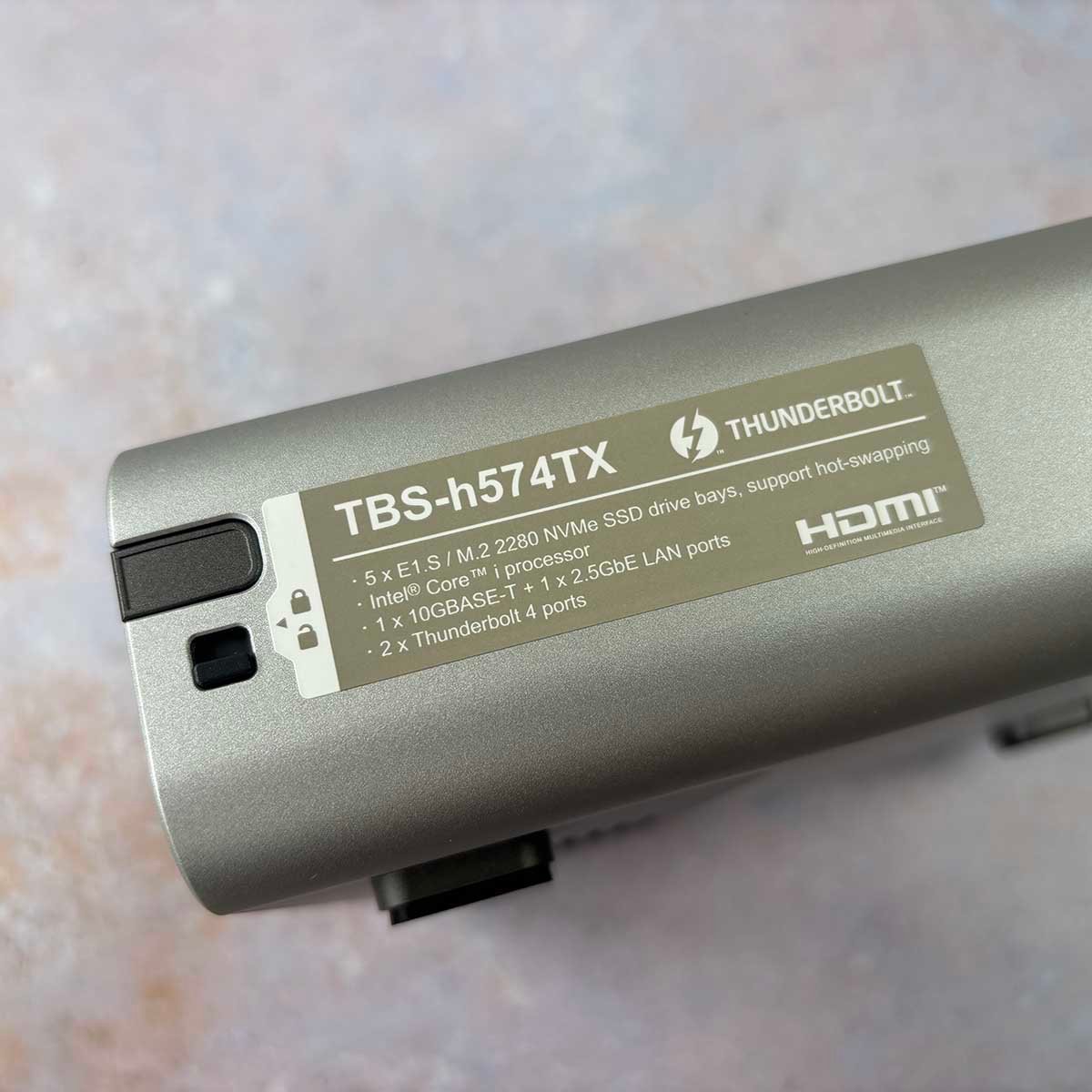
The unit is versatile enough to use E1.S SSDs of various dimensions, including common z heights such as 5.9mm, 9.5mm, and 15mm, but no M.2 adapters are bundled in for the obvious reason that it’s already chock-full of drives. The barebone unit, meanwhile, does have said adapters bundled into its package. Accessing the hot-swappable drives is as simple as disengaging the locking mechanism for the magnetically attached front panel. Et voila, access to all five E1.S SSDs.
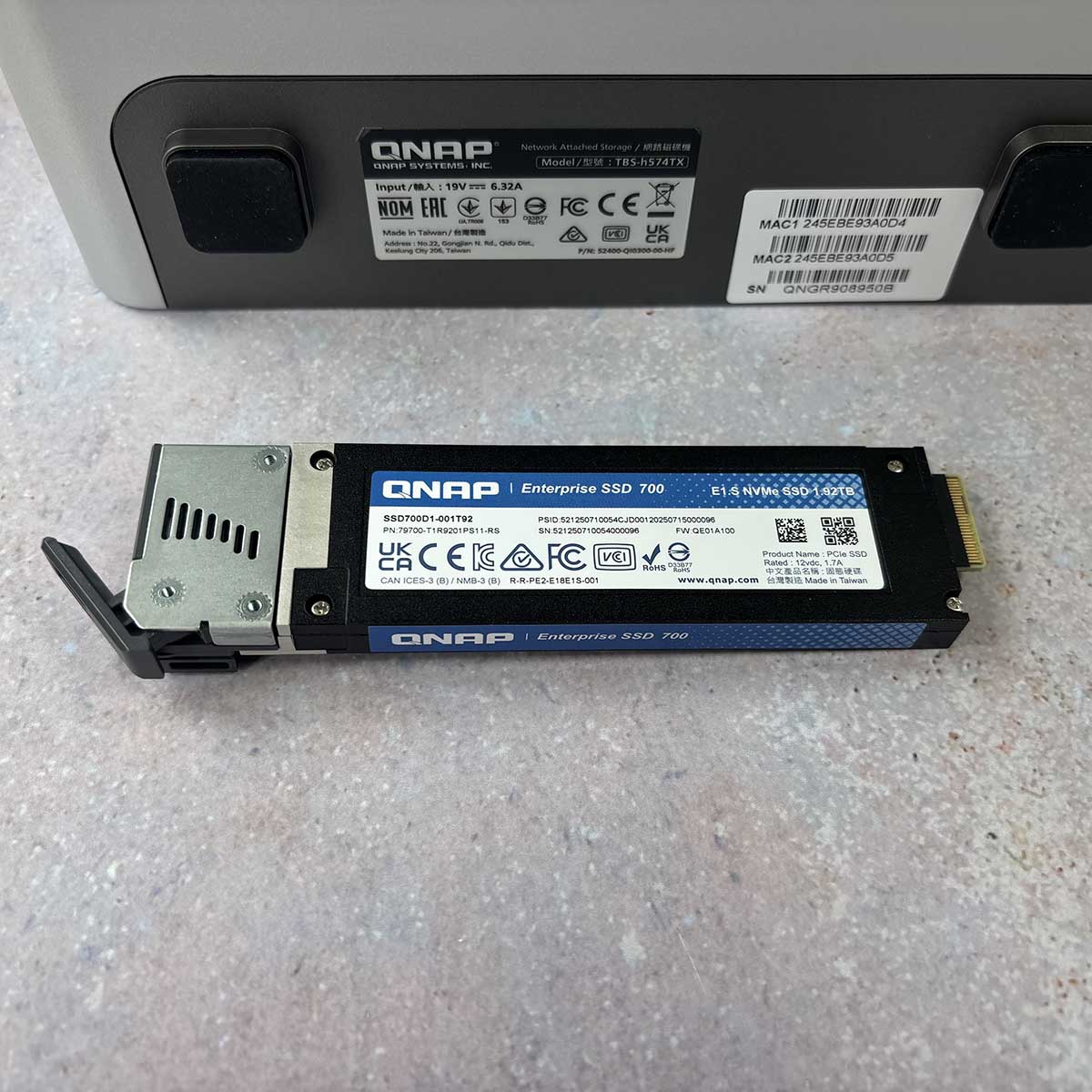
QNAP uses an in-house-branded Enterprise SSD 700 E1.S NVMe 1.92TB SSD in each slot. It pulls out with a satisfying click, and I’m one who appreciates solid build quality. The metal heatsink and industrial design feels like it should belong in a server, which it does in certain rack mounts.
Though I don’t recommend you do this because it will void the three-year warranty, accessing the actual drive, for educational purposes of course, is done by removing four small screws. The upper part of the heatsink then comes away with a little tug.
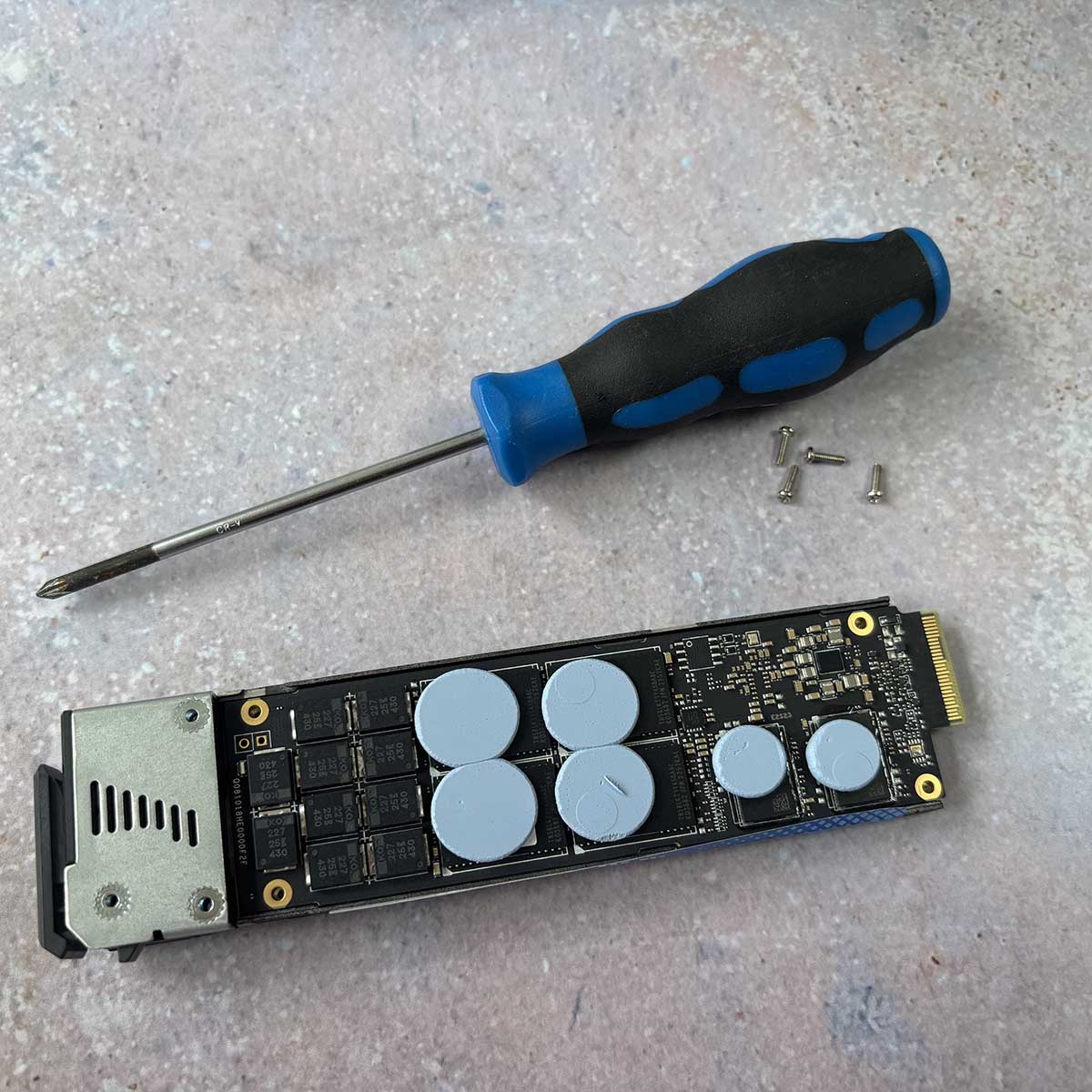
I like the attention to detail paid in every part of the design. The 1.92TB NAND is covered by four Blu Tak-like thermal pads that make good contact with the heatsink I just pulled away. A couple of DRAM buffering chips also get the same treatment, albeit with smaller blobs, and the capacitors that make hot-swapping possible line the left-hand side. It’s not immediately clear who the original manufacturer is, though industry stalwart Phison provides the controller. An educated guess says this is a rebranded Micron drive outfitted with a PCIe 4.0 x4 NVMe interface.
Firing it up, noise, and performance
QNAP supplies a 120W AC adapter and a high-quality RJ45 cable for connecting to a network. There’s no Thunderbolt 4 cable, which is an oversight in my opinion, as that’s one of the primary ways to connect the unit to your local PC.
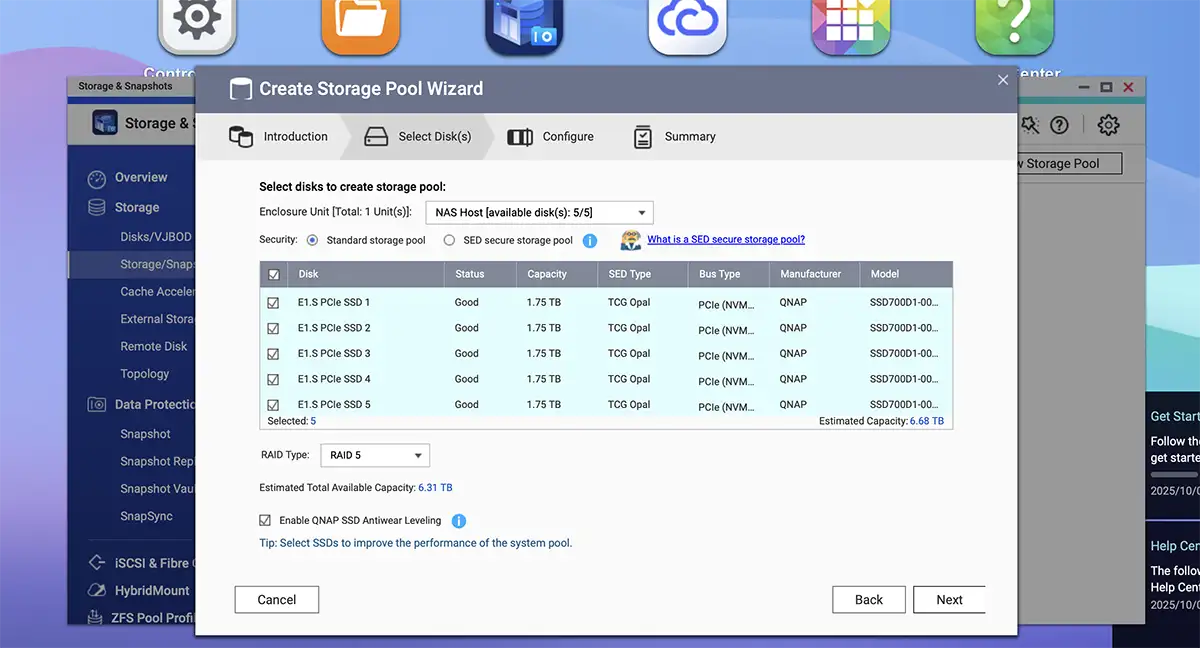
Getting from a boxed-up unit to a fully-functioning array takes fewer than 30 minutes, and you don’t need any specialist NAS knowledge to do so. Simply log into the box on your network, create your desired storage pool – RAID 5 in my case, offering a good balance between redundancy and performance – and wait for the operating system to do its thing. Depending upon exactly how you configure it, some capacity may be lost, but this is absolutely the par for the course when building storage arrays. A plus point is you can use either QNAP’s ZFS-based QuTS Hero or the QTS interfaces.
It’s immediately apparent that QNAP priorities reliability over near-silent operation. The box of tricks carries two 40mm exhaust fans you see by the rear ports plus a 75mm spinner on the Core i5 CPU. They combine to produce a steady yet noticeable hum at all times, and I wouldn’t consider this solution in a recording environment due to the ever-present noise. There’s no easy way around this problem as having a hardware transcode-capable Core i5 and attendant components means wattage and heat are always present. I measured an idle 36W and 73W when writing to the NASbook. One simply isn’t able to passively cool that kind of heat in a chassis of this size.

Using my MacBook 16 Pro connected via Thunderbolt 4, I transferred over a 221.1GB folder in a smidge over two minutes, translating to around 1.8GB/s.
| Metric | Transfer speed |
|---|---|
| Thunderbolt 4 to NAS | 1,827MB/s |
| 10Gbps USB to NAS | 949MB/s |
| 10GbE to NAS | 1,072MB/s |
Accesses to and from the QNAP NASbook occur most quickly when connected via Thunderbolt to a single local computer. This makes sense due to the interface’s faster speed. Note, however, that I’m able to max out both the Ethernet and USB connections, suggesting that the QNAP is running in optimal form.
Having near-instant access to the network-attached drive means you can leave large projects on there and edit remotely, while the Intel Core i5’s ability to hardware transcode on the fly, thanks to the qualities of its built-in graphics, is a boon for creative types. I saw no evidence of slowdowns during my use, but I do wonder if the lower power of this unit’s Core i5-1235U will cause potential wrinkles when running flat out for extended periods.
Putting it together, I see QNAP TBS-h574TX-i5UC-05S01 as part of a creative’s on-site toolkit. Ingesting high-resolution video from a camera’s SD cards onto the unit, you can edit it via a Thunderbolt-attached computer, saving that laptop’s storage space in the process. Meanwhile, the handy transcoding ability enables easy sharing and backups.
Conclusion
There is no one size fits all when it comes to NAS appliances. QNAP has spotted a gap in the market for a small, portable, high-performance all-flash NAS primed for creatives to smooth their workflow and save time and effort. Though a barebones unit exists, QNAP provides a frictionless turnkey solution in the wonderfully named TBS-h574TX-i5UC-05S01, but do be aware that convenience comes at the expense of a less-powerful CPU.
Armed with five E1.S drives and ready to go within 30 minutes of getting it out of the box, there’s a lot to like about its simplicity and predictable performance. In an ideal world, I’d prefer a quieter unit that’s less aurally obtrusive when sat on a desk, but that’s what headphones are for.
The QNAP TBS-h574TX-i5UC-05S01 is a necessarily niche NAS that taps into the needs of the burgeoning creative industry. It’ll sit alongside your MacBook Pro, Studio Display, and high-end DSLR while not feeling out of place, both in looks and performance.

